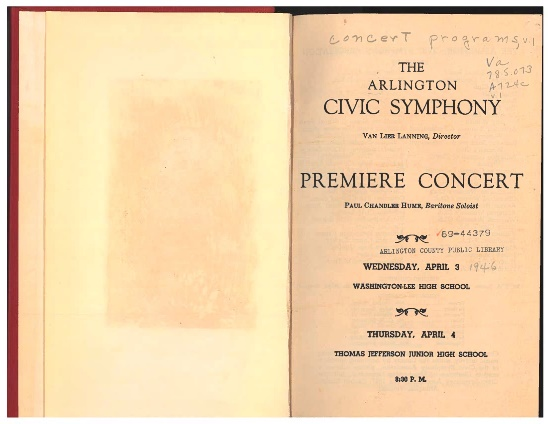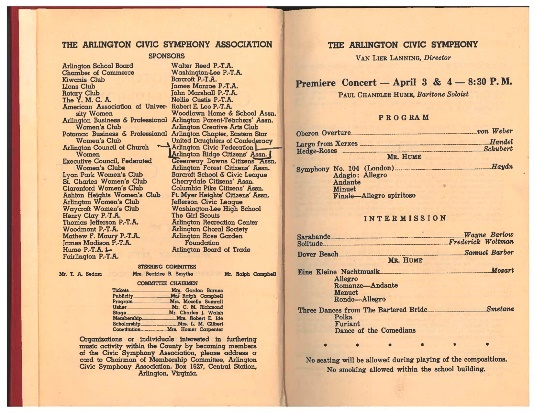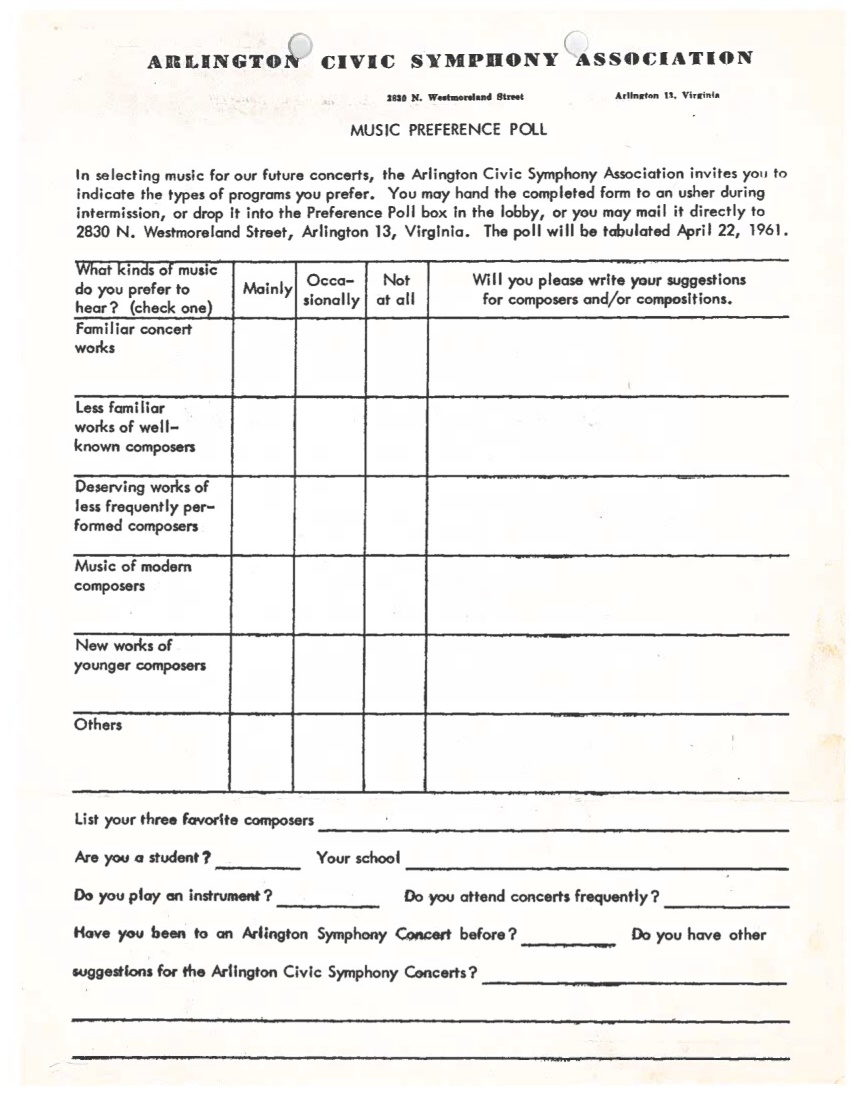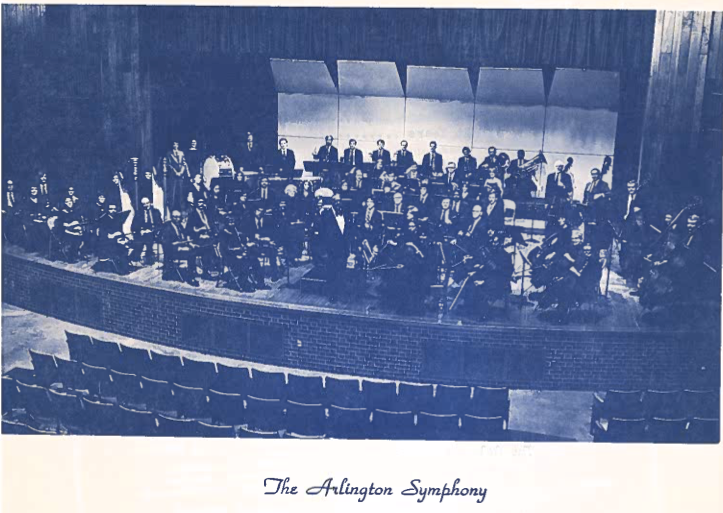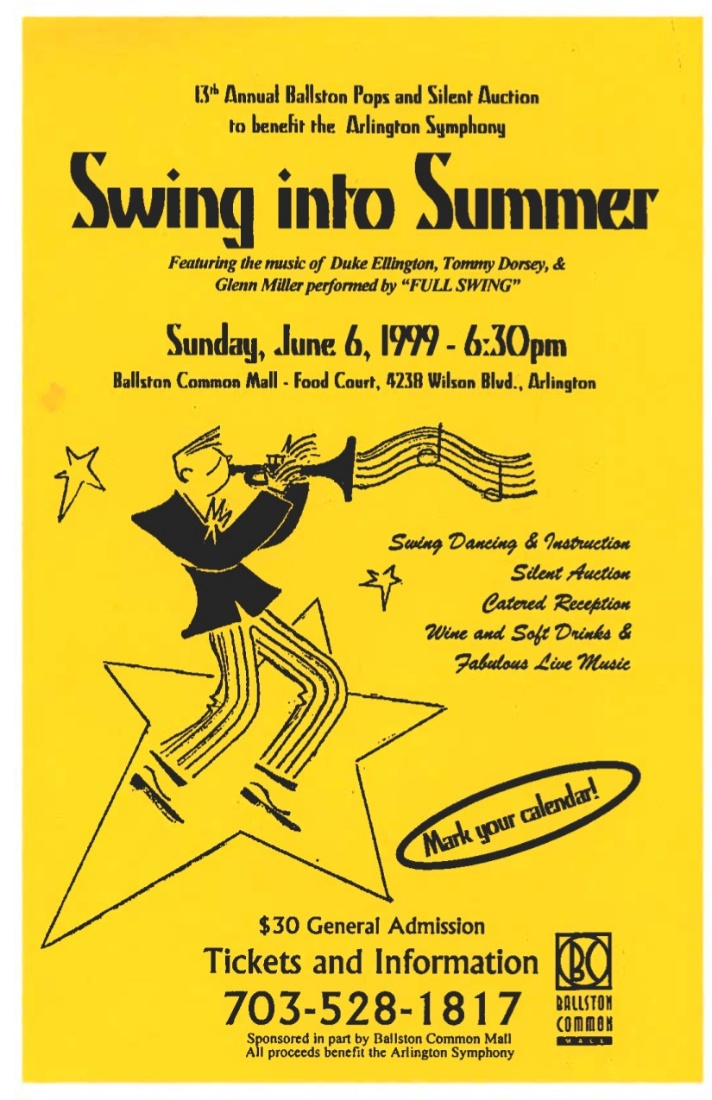Between 1945 and 2005, Arlington County was home to the renowned Arlington Symphony, organized and maintained as a volunteer effort by members of the community.
Over its 60-year run, the symphony performed a wide variety of music across the County and was one of Arlington's first, and longest-running, arts organizations.
Excerpt from the Washington Post’s 40th-anniversary feature on the Arlington Symphony. Image courtesy of the Washington Post.
First Movement
The Arlington Symphony was organized in the years following World War II, providing a source of respite from the turmoil of the wartime years.
Van Lier Lanning – an Arlington resident – was the leader of these initial organizing efforts. Lanning had also organized and directed the War Production Board orchestra during WWII. Lanning’s vision was to establish a suburban orchestra. This dream materialized in late 1945 as local citizens began to sign on to establish what was called a “civic orchestra.”
A volunteer group of Arlingtonians formed a Steering Committee and recruited players, who also chipped in $10 apiece for the purchase of sheet music. Ellis Chasens, former concertmaster of the War Production Board Orchestra, signed on as the Arlington Symphony’s first concertmaster.
Opening Night
Program excerpts from the Arlington Symphony’s first concert on April 3, 1946.
The premiere concert took place on Friday, April 3, 1946, at Washington-Lee High School (now Washington-Liberty). This opening night featured baritone soloist Paul Hume, who went on to serve as the Washington Post’s music critic. The evening was a resounding success, and a second performance followed the next evening. Another performance in June followed, and by fall 1946, plans for a full program were underway.
A program of eight concerts was approved for the following year: four of them would be evening, adults-only, concerts and four would be Sunday afternoon children’s concerts, followed by performances of a youth orchestra. This set the pattern for the orchestra’s early schedules.
Tickets in this first program year were 75 cents for the adult concerts and 30 cents for the children’s concerts. From 1951-1968, programming was free, but tickets were reinstated in later years to accommodate for budgeting gaps.
Numerous conductors served in these early years, but by the 1954-1955 season, the position went unoccupied due to insufficient funds for the part-time work. Later that year, John Wigent signed on to the job. Wigent, a trained clarinetist and double bassist, had previously served as Harry Truman’s pianist and as an organ player at the Arlington Temple in Rosslyn. Karl Rucht signed on as the next director, where he served for more than 15 years. Rucht was known for his drama, flare, and “spectaculars” – including full concert versions of operas, special soloists, and concerts with more than 300 performers on stage.
Karl Rucht, the Arlington Symphony’s Music Director from 1960-1985.
Style and Substance
One of the Symphony’s signature elements was solo performers, who were featured in the hundreds over the course of the symphony’s seasons. The soloist program was not only a chance to highlight talent, but it also broadened the scope of the Symphony, as they included performers from across the nation and abroad. One of the Symphony’s most popular soloists was Evelyn Swartout, who performed four consecutive years in a row.
The soloist program was also a way to incorporate younger members of the Arlington community, who were sometimes selected from the Association’s scholarship program. In the 1940s, public education in music was limited, and the Symphony filled this gap with its musical programming, even as the move toward public music courses increased in later decades.
Organization and Funding
The Symphony Association, County government, and other civic and social groups often worked together to help support the group’s artistic efforts. Spaces for rehearsals and concerts were provided by the School Board for no or reduced fees, and in 1966, members of the Association met with County Manager Bert Johnson, who provided $3,600 in funding from the County budget. This arrangement lasted for much of the symphony’s lifetime, increasing over the years due to inflation. Other fees were supplemented by Association fundraising and external grants.
The Association’s Board of Directors was incorporated in 1966 and consisted of 26 to 30 members. The group was augmented and supported by a Women’s Committee for the Symphony, as well, which consisted of 114 members by 1980.
In 1980, March was designated as “Arlington Symphony Month” by the Arlington County Board.
In 1985, the Arlington Symphony celebrated its 40th anniversary – among its members that season was a 40-year veteran of the symphony, Caurine Easterling. A write-up on the event in the Washington Post notes the symphony’s range of ages – from teenagers to octogenarians – and also notes that this was the final season Karl Rucht served as musical director.
Photo of the Arlington Symphony, from “The Story of the Arlington Symphony Association: Trials and Triumphs of a Volunteer Effort,” published in 1980.
Final Act
The Arlington Symphony came to a close in 2005 after declaring bankruptcy. Its final music director was Ruben Vartanyan, who served with the symphony for 13 years. In 2006, a group of former Symphony members joined together as the Arlington Philharmonic, and Vartanyan directed the new group’s inaugural concert, leading a performance of Tchaikovsky's Serenade for Strings, Op. 48.
Arlington is still home to the Arlington Philharmonic, as well as the Arlington Concert Band and many other classically-focused musical groups and other musical organizations.
Want to learn more? Arlington’s Center for Local History holds records of the Arlington Symphony in RG 54, and documents related to the Arlington Symphony are also available in RG 57, the personal papers of Hugh Johnson, who served as one of the Symphony’s presidents.
CLH also has an oral history interview in its collections with Theodore and Jean Taylor, where the couple describes the early days of the symphony and their involvement in the group, including Jean Taylor’s role as president of the Women’s Committee.
To learn more about Arlington's history, visit the Center for Local History on the first floor of the Central Library.
Do you have a question about this story, or a personal experience to share?
Use this form to send a message to the Center for Local History.
Center For Local History - Blog Post Message Form
Do you have a question about this story, or a personal experience to share? Use this form to send a message to the Center for Local History.
"*" indicates required fields

